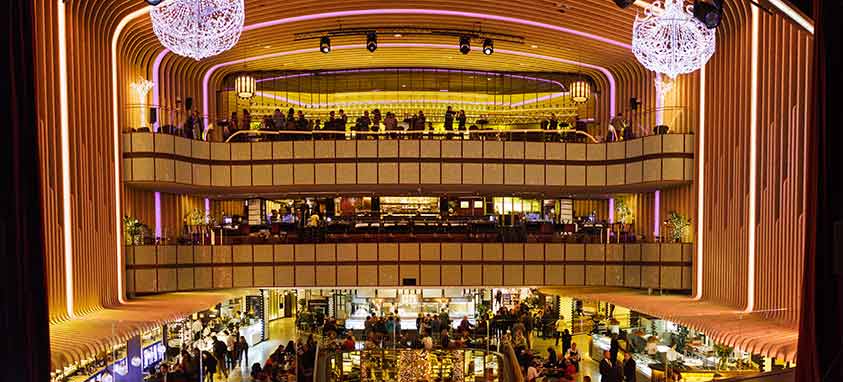Spain’s capital is a sweet spot for conferences and events
Within the next 24 months, several factors may influence planners to seriously consider Madrid as an international meeting destination. The steep decline in the euro’s value—predicted to remain at a low exchange rate into 2016—means that American and Chinese attendees in particular will get great value for their money. What’s more, European attendees will likely prefer to stay on the continent rather than face an unfavorable exchange rate elsewhere. And for planners who can negotiate their various meeting elements in the near future and pay in U.S. dollars, the return on investment will approach an all-time high.
Other elements make Madrid a sweet spot for conferences. It’s centrally located, with an airport that is Europe’s hub to Latin America; it’s a focal point for multinational corporations to have a presence; and it’s a crossroads of several cultures—from ancient Roman to Muslim Moorish, Habsburg and modern Iberian. Based on the sheer number of international events that come to Madrid and the positive feedback from attendees and planners alike, it is consistently ranked in the top five worldwide conference destinations by the International Congress and Convention Association (ICCA).
Group Experiences
One aspect that makes Madrid a fascinating spot for meetings is the breadth of options after the days’ sessions end. After business hours, even the largest groups have a variety of special event venues from which to choose. Jardines de Sabatini is a huge, neoclassical garden adjacent to the Royal Palace featuring three terraces, elaborate fountains and statues of Spanish kings. When theatrical and musical shows aren’t taking place, the garden is available in three seasons for private receptions. It can accommodate several thousand attendees.
The Glass Gallery at Cibeles Palace is a 26,000-square-foot glass atrium, once part of the 17th-century Buen Retiro Palace, now part of Madrid City Hall. Matadero Madrid—a riverfront slaughterhouse complex that was central to commerce and everyday life in Madrid throughout the early 20th century—has been transformed into an artistic center that offers huge spaces for special events. And the Stock Exchange Palace, a 1893 neoclassical landmark with huge frescoes, sculptures, period furnishings and opulent trim, can be used for receptions or award programs in the evenings.
As for sporting venues that radiate Spanish culture, groups can witness a bullfight at Las Ventas Bullring, Ernest Hemingway’s favorite in life and in literature. The ring can be the setting for gala dinners, celebrations and concerts. Santiago Bernabeu Stadium, home of the famed Real Madrid soccer club, has 20 meeting rooms that could make for a memorable day of sessions; in the evening, groups can access parts of the field and take guided tours of the locker rooms.
Like this content? Click here to get it Delivered FREE to your Inbox or your Mailbox
Madrid’s many art museums have a stellar pedigree for receptions, formal tours and as an option for attendees in their off hours. Museums on Paseo del Prado, Madrid’s “Avenue of Art,” includes the Prado, Reina Sofia, and Thyssen (and since 2007, the Caixa
Forum). Housed in an 18th century neoclassical building, the Prado features an incredible collection of works by European masters such as Velazquez, Goya, Raphael, Rubens and Bosch, plus other renowned Italian and Flemish artists.
The Reina Sofia, housed in a renovated 18th-century hospital, is a treasure trove of contemporary and modern art. It displays works by Miro and Dali, as well as arguably the 20th century’s most famous painting, Picasso’s “Guernica.” Inside the Thyssen—a neoclassical mansion from 1806—is perhaps the world’s most important private art collection. Assembled by Baron Heinrich Thyssen-Bornemisza and his son, Hans Heinrich, it illustrates the history of Western art, from the primitive Flemish and Italian painters to 20th-century pop art. Works by Rubens, Rembrandt, Van Gogh, Cezanne, Dali, Picasso and Pollack are stunning.
Attendees can visit all three of these museums for less than $16 with the Abono Paseo del Arte card, which can be purchased at any of them. The world-famous Cibeles Fountain is located at the northern end of the boulevard, just blocks from the Thyssen. Surrounded on three sides by midsize 19th-century palaces and the equally stunning Bank of Spain building, the fountain is perhaps the most iconic spot in Madrid. Alternatively, for groups that prefer a narrated bus tour of the aforementioned museums, palaces and sporting venues—plus the Jardines de Sabatini and a tour of the adjacent Royal Palace—there’s a Viator half-day jaunt for $46 per person.
 Flamenco nightclub and restaurant Casa Patas
Flamenco nightclub and restaurant Casa Patas
Food & Dance
Moving from place to place, eating different raciones (servings) set on small plates, is a deep-rooted Madrid tradition. These dishes, called tapas, are prepared with regional ingredients and seasonings. Guided tapas tours transport groups through popular restaurants and authentic taverns in the old quarter of the La Latina district, or in Palacio, Huertas and other lively neighborhoods.
In La Latina, participants can sample tapas from eateries on bustling Cava Baja Street; try Meson del Champinon, Meson de la Tortilla and Las Cuevas de Luis Candelas. In Palacio, adjacent to the impressive Plaza Mayor city center, groups can peruse the colorful Mercado de San Miguel, a reconstructed covered market that offers a multitude of gourmet tapas. Huertas is also known as Barrio de las Letras (the literary neighborhood) because it was home to writers such as Miguel de Cervantes and Lope de Vega. Its many traditional bars and restaurants make a walking tapas event easy to coordinate.
The entertaining Mercado de San Anton is in Madrid’s Chueca neighborhood. A huge variety of food is spread across three floors that are interconnected but open at different hours, which is perfect for groups with busy meeting schedules. Sprinkle eye candy into a tapas tour by targeting the Recoletas or Goya districts; both are home to the ritziest shops and traditional food establishments. Platea Madrid is a five-story facility on Plaza de Colon with different gastronomic experiences on each floor—from formal dining to tapas tasting—along with live entertainment spaces.
Meeting groups can sample Madrid’s cuisine while enjoying flamenco dancing. Venues that host such shows are called tablaos and generally charge a set per-person fee for food, drinks and the show. In addition to the dozens of places around town offering this, the outdoor summer shows at Jardines de Sabatini often feature flamenco dancing. For adventurous groups interested in a fun and original icebreaking activity, some venues will provide flamenco lessons. The dance school El Horno, located near Plaza Mayor, offers beginners’ sessions. One of the most important flamenco spots in the city, Corral de la Moreria, offers its restaurant and show area for this activity for up to 70 people.
Rooftop Receptions
Don’t have much time in the meeting program to explore Madrid? The next best thing might be to let attendees gaze on the beautiful neoclassical buildings, old churches, elaborate fountains and green spaces from a high rooftop. There are group-friendly bars and lounges at the top of several hotels and other establishments throughout the city. With Madrid’s average high temperature about 64 degrees in April, 80 degrees in July and 66 degrees in October, these spaces can handle receptions many months of the year.
The Roof terrace bar at ME Madrid Hotel looks down on Plaza de Santa Ana and the Literary Quarter. One of its two spaces can be booked for groups. The vast rooftop terrace of Ada Palace Hotel on Gran Via offers spectacular views of the city center, including the magnificent dome of the Metropolis building and Cibeles Fountain. Emperador Hotel, farther down Gran Via, has a rooftop garden and pool. And Iberostar Las Letras Gran Via Hotel has a sophisticated terrace with views, abundant foliage and a misting system that keeps guests cool on hot summer nights.
Other venues with rooftop spaces include Fine Arts Circle, with 360-degree vistas and an international street food menu; the Escuelas Pías building, with the rooftop Gau Café and San Anton Market in the Chueca district with a 4,000-square-foot terrace for receptions and fine dining. Also, the gourmet section of the El Corte Ingles shop on Gran Via recently moved to the top floor of the building, and guests can take a drink or snack to the outdoor terrace and look down on bustling Plaza de Callao.
Rob Carey is a business journalist and principal of Meetings & Hospitality Insight, a content marketing firm for the group-business market.
Resources
-Feria de Madrid (IFEMA) Exhibition Complex
ifema.es/convencionesycongresos_06
-Tourism Office of Spain
spain.info
-Visit Madrid
esmadrid.com/en
Major Meeting Venues
Casa de Campo Convention & Trade Fair Centre
Near city center; 430,556 sq. ft. of exhibition space; 400,000 sq. ft. of outdoor space; 215,000-square-foot Glass Pavilion offers panoramic city views; pavilion accommodates 2,000; 660-seat theater.
Centro de Congresos Principe Felipe
Convention center features 166,000 sq. ft. of meeting space; 2,200-seat auditorium; 59 other meeting rooms; adjacent to Hotel Auditorium Madrid; less than 10 minutes from airport.
Five-star property next to Municipal Conference Center; 473 guest rooms; 109,000 sq. ft. of meeting space; largest ballroom in Madrid (15,000 sq. ft.); full spa; free Wi-Fi.
Feria de Madrid (IFEMA) Exhibition Complex
North Building has 107,639 total sq. ft.; 1,100-person auditorium; 20 meeting rooms, two of which access a large outdoor terrace. South Building has 600-person auditorium, plus 10 other rooms; 14 onsite caterers.
Five minutes to IFEMA and Centro de Congresos Principe Felipe; 284 guest rooms; 17,000 sq. ft. of meeting space; free shuttle to city center.
Connected to Centro de Congresos Principe Felipe; 10 minutes from airport; 869 guest rooms; sit-down and buffet restaurants; free airport shuttle.
Five-star historic 1910 Baroque palace in Retiro district, between Prado and Thyssen museums; 167 guest rooms; 11,763 sq. ft. of meeting space; Bodyna Spa; two restaurants; cocktail bar; afternoon tea.
Four-star property near Museum of Natural Sciences; 302 guest rooms; 25,000 sq. ft. of meeting space includes 6,100-square-foot ballroom; fitness center; two restaurants; outdoor terrace for groups of 150.
In city center, near Bernabeu Stadium; 915 guest rooms; 75,000 sq. ft. of meeting space includes large auditorium; two restaurants; outdoor pool; 24-hour gym.
NH Collection Madrid Eurobuilding
One block from Municipal Conference Center; 412 guest rooms; 83,958 sq. ft. of meeting space with 10,000-square-foot ballroom; holographic tele-
presence system for meetings; three restaurants; Elysium Spa.
Reopens in early 2016 after full renovation; located next to El Retiro Park; 790 guest rooms; 24,000 sq. ft. of meeting space; two restaurants; fitness center and outdoor pool; 24-hour airport express.
Palacio Municipal de Congresos de Madrid
Near IFEMA; integrated into Campo de las Naciones, 322,000 sq. ft. includes exhibition areas, two auditoriums; 31 other rooms; fourth-floor VIP area has large meeting hall, offices, two private restaurants; 15 minutes from city center by Metro; five minutes from Adolfo Suarez Madrid-Barajas Airport (MAD).
Sheraton Madrid Mirasierra Hotel & Spa
Five-star hotel in central business district; 182 suites; 18,793 sq. ft. of meeting space; Absara Spa with Turkish bath; fitness center; restaurant; two bars; poolside lounge serves tapas.
Five-star property with avante-garde design; 315 guest rooms; 9,500 sq. ft. of meeting space; pool.
1912 Belle Epoque building with antique furnishings and mahogany throughout; 467 guest rooms; 16,275 sq. ft. of meeting space includes 15 multifunction rooms, plus glass dome for receptions; two restaurants; full gym with city views.






